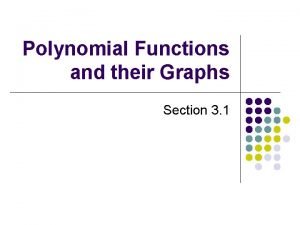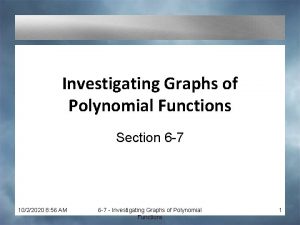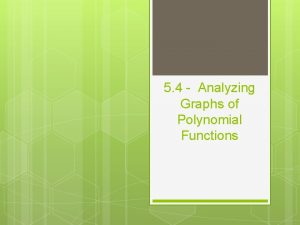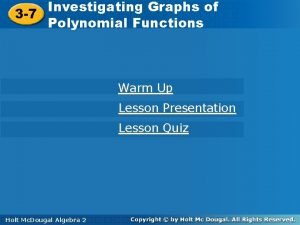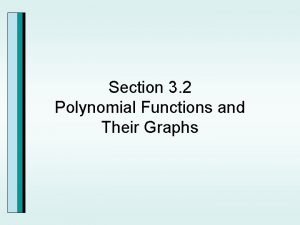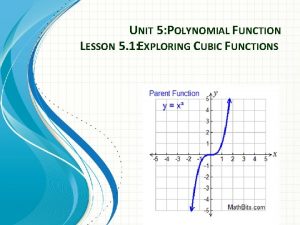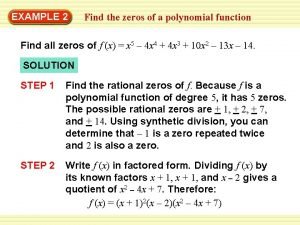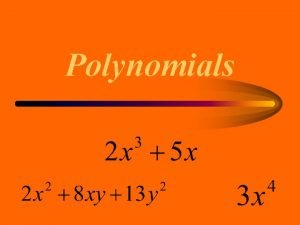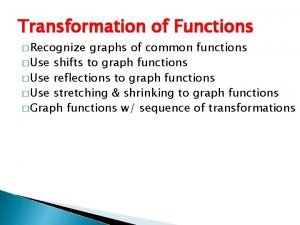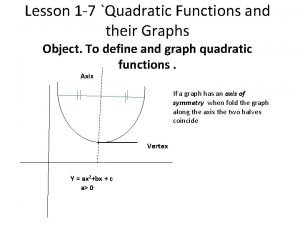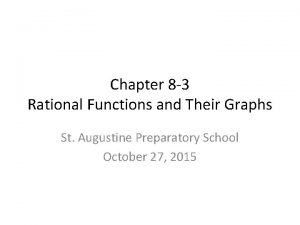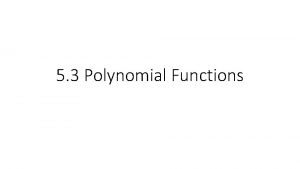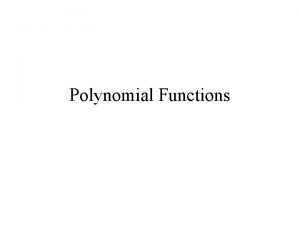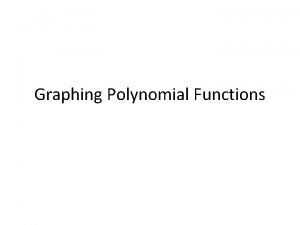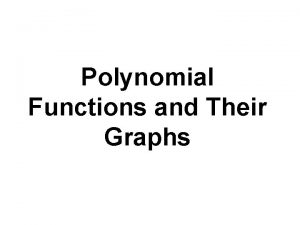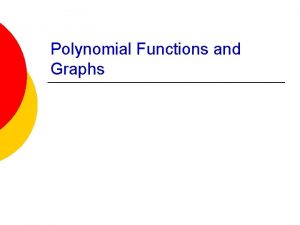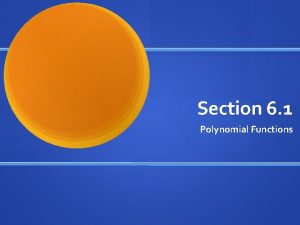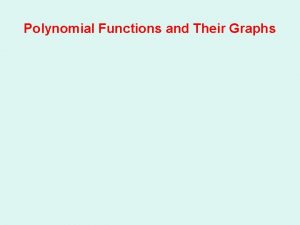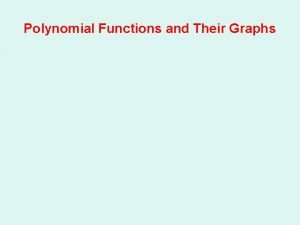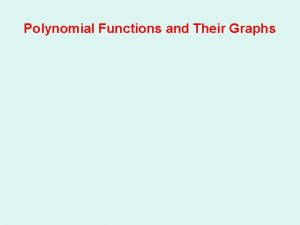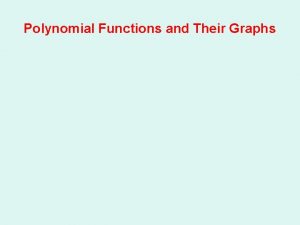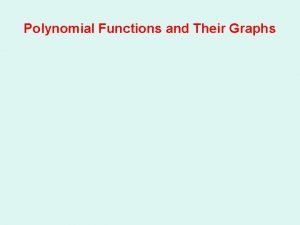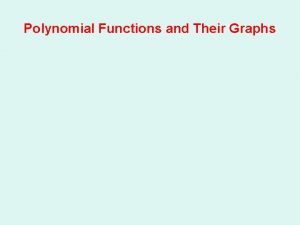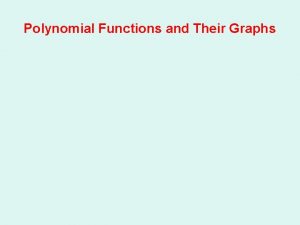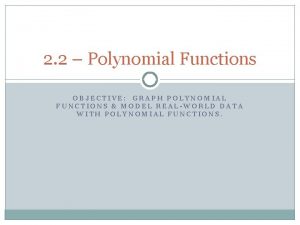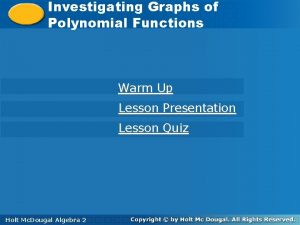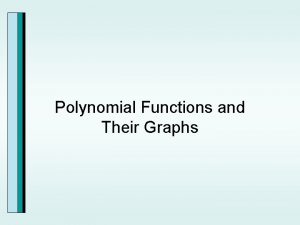Graphs of Polynomial Functions Section 5 3 Polynomial






















- Slides: 22

Graphs of Polynomial Functions Section 5 -3

Polynomial Functions Polynomial Function in General Form Degree Name of Function 1 2 3 4 Linear Quadratic Cubic Quartic The largest exponent within the polynomial determines the degree of the polynomial.

Explore Polynomials Linear Function Quadratic Function Cubic Function Quartic Function

Leading Coefficient The leading coefficient is the coefficient of the first term in a polynomial when the terms are written in descending order by degrees. For example, the quartic function f(x) = -2 x 4 + x 3 – 5 x 2 – 10 has a leading coefficient of -2.

Cubic Polynomials Look at the two graphs and discuss the questions given below. Graph A Graph B 1. How can you check to see if both graphs are functions? 2. How many x-intercepts do graphs A & B have? 3. What is the end behaviour for each graph? 4. Which graph do you think has a positive leading coeffient? Why? 5. Which graph do you think has a negative leading coefficient? Why?

Increasing, Decreasing, Constant Intervals A function f is increasing on an interval if as x increases, then f(x) increases. A function f is decreasing on an interval if as x increases, then f(x) decreases. A function f is constant on an interval if as x increases, then f(x) remains the same.

End Behavior of Functions The end behavior of a graph describes the far left and the far right portions of the graph. Using the leading coefficient and the degree of the polynomial, we can determine the end behaviors of the graph. This is often called the Leading Coefficient Test.

End Behavior of Functions First determine whether the degree of the polynomial is even or odd. degree = 2 so it is even Next determine whether the leading coefficient is positive or negative. Leading coefficient = 2 so it is positive

END BEHAVIOR Degree: Even Leading Coefficient: End Behavior: Up Up +

END BEHAVIOR Degree: Even Leading Coefficient: End Behavior: Down

END BEHAVIOR Degree: Odd Leading Coefficient: + End Behavior: Down Up

END BEHAVIOR Degree: Odd Leading Coefficient: End Behavior: Up Down

END BEHAVIOR PRACTICE Give the End Behavior:

END BEHAVIOR PRACTICE Give the End Behavior: Up Down

Cubic Polynomials The following chart shows the properties of the graphs on the left. Equation Factored form & Standard form X-Intercepts Sign of Leading Coefficient Factored y=(x+1)(x+4)(x-2) Standard -4, -1, 2 Positive As x , y and x - , y - Negative As x , y - and x - , y y=x 3+3 x 2 -6 x-8 Factored y=-(x+1)(x+4)(x-2) Standard y=-x 3 -3 x 2+6 x+8 -4, -1, 2 End Behaviour Domain and Range Domain {x| x Є R} Range {y| y Є R}

Cubic Polynomials The following chart shows the properties of the graphs on the left. Equation Factored form & Standard form X-Intercepts Sign of Leading Coefficient Factored y=(x+3)2(x-1) Standard -3, 1 Positive y=x 3+5 x 2+3 x-9 Factored y=-(x+3)2(x-1) Standard y=-x 3 -5 x 2 -3 x+9 -3, 1 Negative End Behaviour As x , y and x - , y - As x , y - and x - , y Domain and Range Domain {x| x Є R} Range {y| y Є R}

Cubic Polynomials The following chart shows the properties of the graphs on the left. Equation Factored form & Standard form X-Intercepts Sign of Leading Coefficient Factored y=(x-2)3 Standard 2 Positive y=x 3 -6 x 2+12 x-8 Factored y=-(x-2)3 Standard y=-x 3+6 x 2 -12 x+8 2 Negative End Behaviour As x , y and x - , y - As x , y - and x - , y Domain and Range Domain {x| x Є R} Range {y| y Є R}

Quartic Polynomials Look at the two graphs and discuss the questions given below. Graph A Graph B 1. How can you check to see if both graphs are functions? 2. How many x-intercepts do graphs A & B have? 3. What is the end behaviour for each graph? 4. Which graph do you think has a positive leading coeffient? Why? 5. Which graph do you think has a negative leading coefficient? Why?

Quartic Polynomials The following chart shows the properties of the graphs on the left. Equation Factored form & Standard form XIntercepts Sign of Leading Coefficient Factored y=(x-3)(x-1)(x+2) Standard -2, -1, 1, 3 Positive y=x 4 -x 3 -7 x 2+x+6 Factored y=-(x-3)(x-1)(x+2) Standard y=-x 4+x 3+7 x 2 -x-6 -2, -1, 1, 3 Negative End Behaviour As x , y and x - , y As x , y - and x - , y - Domain and Range Domain {x| x Є R} Range {y| y Є R, y ≥ -12. 95} Domain {x| x Є R} Range {y| y Є R, y ≤ 12. 95}

Quartic Polynomials The following chart shows the properties of the graphs on the left. Equation Factored form & Standard form XIntercepts Sign of Leading Coefficient Factored y=(x-4)2(x-1)(x+1) Standard -1, 1, 4 Positive y=x 4 -8 x 3+15 x 2+8 x-16 Factored y=-(x-4)2(x-1)(x+1) Standard y=-x 4+8 x 3 -15 x 2 -8 x+16 -1, 1, 4 Negative End Behaviour As x , y and x - , y As x , y - and x - , y - Domain and Range Domain {x| x Є R} Range {y| y Є R, y ≥ -16. 95} Domain {x| x Є R} Range {y| y Є R, y ≤ 16. 95}

Quartic Polynomials The following chart shows the properties of the graphs on the left. Equation Factored form & Standard form XIntercepts Sign of Leading Coefficient Factored y=(x+2)3(x-1) Standard -2, 1 Positive y=x 4+5 x 3+6 x 2 -4 x-8 Factored y=-(x+2)3(x-1) Standard y=-x 4 -5 x 3 -6 x 2+4 x+8 -2, 1 Negative End Behaviour As x , y and x - , y As x , y - and x - , y - Domain and Range Domain {x| x Є R} Range {y| y Є R, y ≥ -8. 54} Domain {x| x Є R} Range {y| y Є R, y ≤ 8. 54}

Quartic Polynomials The following chart shows the properties of the graphs on the left. Equation Factored form & Standard form XIntercepts Sign of Leading Coefficient Factored y=(x-3)4 Standard 3 Positive y=x 4 -12 x 3+54 x 2 -108 x+81 Factored y=-(x-3)4 Standard y=-x 4+12 x 3 -54 x 2+108 x-81 3 Negative End Behaviour As x , y and x - , y As x , y - and x - , y - Domain and Range Domain {x| x Є R} Range {y| y Є R, y ≥ 0} Domain {x| x Є R} Range {y| y Є R, y ≤ 0}
 5-3 polynomial functions
5-3 polynomial functions Types of polynomial
Types of polynomial Investigating graphs of functions for their properties
Investigating graphs of functions for their properties Investigating graphs of polynomial functions
Investigating graphs of polynomial functions Investigating graphs of polynomial functions
Investigating graphs of polynomial functions 5-4 analyzing graphs of polynomial functions
5-4 analyzing graphs of polynomial functions Analyzing graphs of polynomial functions calculator
Analyzing graphs of polynomial functions calculator 6-7 investigating graphs of polynomial functions
6-7 investigating graphs of polynomial functions Polynomial functions and their graphs
Polynomial functions and their graphs Unit 5: polynomial functions
Unit 5: polynomial functions 5-4 practice analyzing graphs of polynomial functions
5-4 practice analyzing graphs of polynomial functions State graph in software testing
State graph in software testing Graphs that compare distance and time are called
Graphs that compare distance and time are called Graphs that enlighten and graphs that deceive
Graphs that enlighten and graphs that deceive Polynomial
Polynomial Domain of trig functions
Domain of trig functions Vertical stretch vs vertical shrink
Vertical stretch vs vertical shrink Hyperbolic tangent
Hyperbolic tangent Lesson 3: rational functions and their graphs
Lesson 3: rational functions and their graphs Quadratic functions and their graphs
Quadratic functions and their graphs Analyzing graphs of functions and relations answers
Analyzing graphs of functions and relations answers Sketch graph of quadratic function
Sketch graph of quadratic function 8-3 rational functions and their graphs
8-3 rational functions and their graphs

